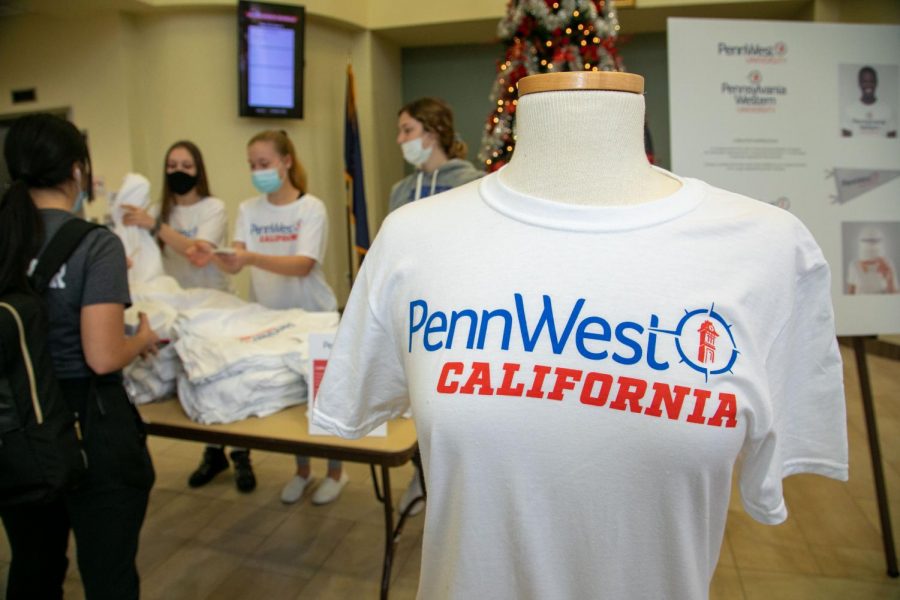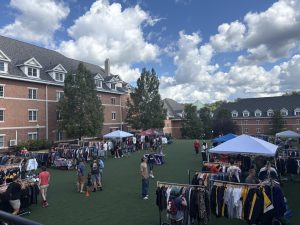The New U: How hybrid classes are becoming the new normal under the PennWest integration
Free T-shirts and stickers featuring the new PennWest logo design were available for students in the Natali Student Center, Dec. 2, 2021. (Photo: Jeff Helsel / Cal Times)
February 3, 2022
Despite PASSHE administrators’ chant that the integration of three universities into Pennsylvania Western University will offer students a wider range of classes, students and faculty remain concerned about online learning effectiveness, the availability of classes, and class sizes.
The integration of California University of Pennsylvania, Clarion University and Edinboro University, slated for June 2022, will change traditional classroom learning. Hybrid classes will be offered at all three campuses, allowing students from all three campuses to enroll in classes offered at any of the universities.
This means students can take classes online, face-to-face, or in multimodality. In a multimodal classroom, classes will be conducted in-person at one campus, and students from the other two campuses will attend synchronously via Zoom.
Dan Engstrom, Cal U’s interim provost, said, the university is still determining which courses will be offered in each of these modalities, but said the decision will be based on first at what’s best for students, and second what the faculty wants.
According to Cal U, the merger should create more course variety for students and open classes from all campuses to everyone.
“If it’s a student at Clarion and they’re taking a history class, they’ll see that class is multimodal, but it is being offered at Cal U. That means if I want to take that class, I’ve got to do it multimodal,” said Engstrom. He also said that offering courses multimodally allows students to experience the expertise of faculty at Clarion and Edinboro that isn’t available at Cal U.
Students who experienced virtual semesters during the COVID pandemic have voiced concerns about having more hybrid or online classes than in-person classes.
“The virtual round of classes killed me,” said Jahneek Fant, a senior dual majoring in secondary education and mathematics. “I just don’t really like online classes.”
Timmy Springer entered Cal U in the fall of 2020 to complete his degree for his career in the Pennsylvania Air National Guard. “I think online learning in any form is hard, and as an adult learning how to do all this technology, I worry that being forced to take a hybrid version of a class with some professor at another school will make it harder to retain any information rather than being in person,” Springer said.
Springer also noted the difficulty he and many of his classmates had with the disengaged discussions over Zoom.
“I just think there is so much more learning and absorbing happening between a live classroom and that cannot be replaced by a computer screen. I mean the pandemic was one thing but choosing to make the class I need only available through another campus isn’t what I came to Cal U for,” Springer said.
With students fearing the online learning aspect of this merger Cal U’s interim president, Dale-Elizabeth Pehrsson, has assured students that their feedback is being heard.
“When we first went to remote learning due to COVID, we did so quickly for health and safety reasons. Refinements were made over time based on feedback from the students. As we integrate, we have had more planning time to further refine delivery. Students should contact Technology Services if they are having connection issues so that this can be addressed,” she said.
Engstrom also understands that this move could also have some difficulties for professors.
“It is extremely hard to teach multimodal,” acknowledged Engstrom. “When I was a faculty member, I moved all around the room. That’s hard with a device that follows you because it has to keep up with me. So, there’s going to be a level of challenge because they’re going to have to adapt to some new things…We’re going to be developing a significant amount of training so that faculty are ready for that so that they’re engaging so that they are rigorous.”
Students also worry that the university would be limiting and cutting programs from the academic curriculum.
Responding to these concerns, Engstrom said that programs were “being synthesized.” The idea of program synthesis is to combine similar programs so a variety of degrees can be offered.
The newly released PennWest program array, which goes into effect in July 2022, will offer degrees under six colleges.
These are the colleges of Arts and Humanities, Natural Sciences and Engineering Technology, Business, Communication, and Information Sciences, Education, Social Sciences and Human Services, and Health Sciences.
Within these colleges, many programs have shifted in their academic angle. Journalism, for example, currently is a concentration in English but will be offered under the communication studies program.
Engstrom said. “If there is a program that goes away…we’re required by the Middle States, our accreditation, that we have to teach those enrolled students out.”
Current Cal U students who are unable to find the classes that are needed per the academic course curriculum must request individualized instruction to maintain their graduation schedule.
Individualized instructions are offered between a student and the professor directly with an approval sourced through the academic chain; however, each professor is only able to offer a strict number of individualized instructions with a limited three students per independent study course and those may become entirely virtual if the students in need of those classes are located at Clarion or Edinboro.
Christina Fisanick, a Cal U associate professor in the Department of Culture, Media and Performance, has offered multiple independent studies throughout her teaching years at Cal. She is concerned about possibly teaching more independent studies after the integration takes effect, and she wants to provide the best possible education for her students.
“The difficulty is that we are providing a personalized curriculum because you can’t just take the previous curriculum from a full class and apply that to two or even three students. It just doesn’t make sense,” Fisanick said.
With the extra burden placed on the faculty of offering an additional study for several students, it is left up to the students and faculty members to arrange a time to meet, which requires scheduling between all parties involved.
“Independent studies require tremendous discipline to succeed and students who need that structured three-day-a-week class schedule may not succeed at something like this,” said Fisanick.
However, she said the faculty is committed to helping students succeed. “They committed to us by choosing Cal. We are just happy to help them complete their degrees and coursework however that needs to happen,” said Fisanick.
Classes taught multimodally across three universities may also result in overcrowding that dilutes the learning experience. Susan Rutledge, an assistant professor in the Department of Education, voiced her concerns about class capacity during a public meeting with Chancellor Dan Greenstein.
“Right now, my capacity in each class that I teach is 35 students. I’m very worried about integration once we all come together, if this does come to fruition, my numbers of students will be pushed up exponentially,” Rutledge said.
Some high school students who attended Cal U’s last open house of the semester also expressed concerns about class sizes increasing. Kristen Koch, a prospective student from South Park, is concerned about how the integration will affect her class sizes. She worries that as the university offers more students on multiple campuses in the same class, the number of students will start to increase exponentially, changing the professor-to-student ratio.
According to Tracey Sheetz, Cal U’s dean of admissions, there has been no indication that class size would change.
“Keep in mind, classrooms are still the same physical size regardless of integration. Capacity is capacity and we have small classrooms at Cal,” she said.
With confirmation from Pehrsson, class sizes for all multi-modal classes will be limited by the number of in-person seats available to ensure that those wishing to attend face-to-face classes will be able to.
Pehrsson said higher education will be facing changes like these over the years, and this integration will demonstrate how these changes will be implemented for other universities looking to integrate with hybrid learning.
The goal of the PennWest integration is to minimize the impact this consolidation would have on each university and be able to sustain the student tuition price without increasing by offering students a hybrid learning environment with a new pool of professors across all campuses with one set tuition price.
“It’s just mind-boggling to me to think how little universities from Western Pennsylvania are being watched by the world,” Pehrsson said.
Faculty, said Rutledge, needs to be given more say in how classes will be offered.
“Faculty are stressed. Faculty are tired. The implication or the inference that we don’t want to work together seems to be kind of apparent. It’s not that we don’t want to work, we want a seat at the table,” said Rutledge. “I understand we need to make money, but I also understand the time constraints that we’re under, and that, needs to be addressed because you’ve got a finite number of people to do all of this work and we need to respect that and address that.”
Fisanick also agrees that faculty have concerns “because it’s new and we don’t know what this will look like in a bigger picture of things.” “But I am looking forward to working with other colleges in other departments from the other schools to work through this,” she said.








